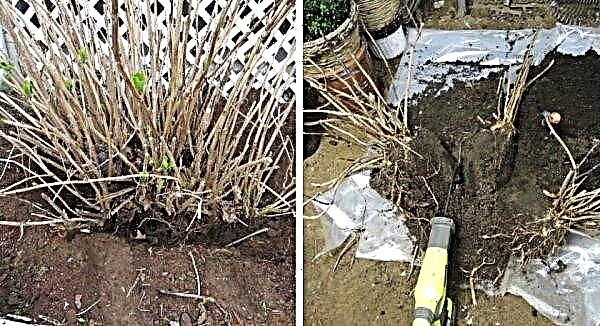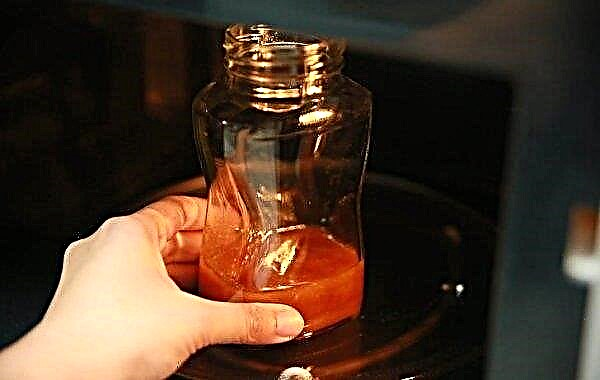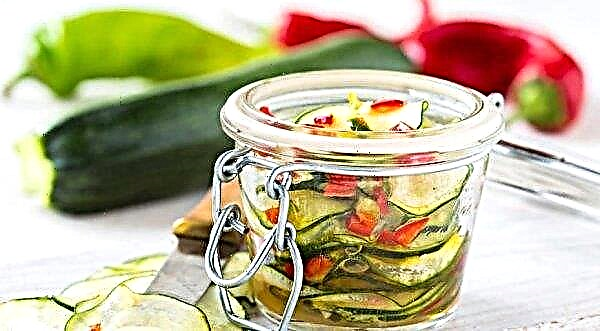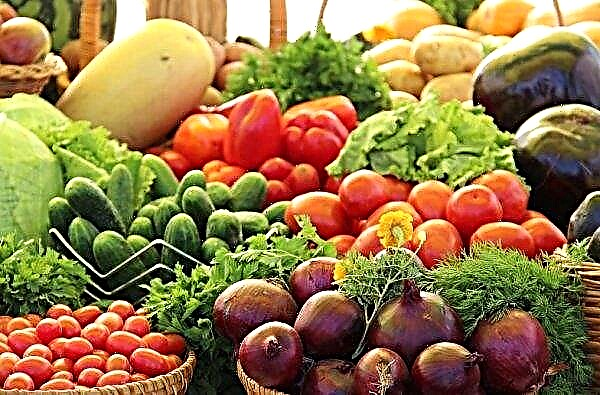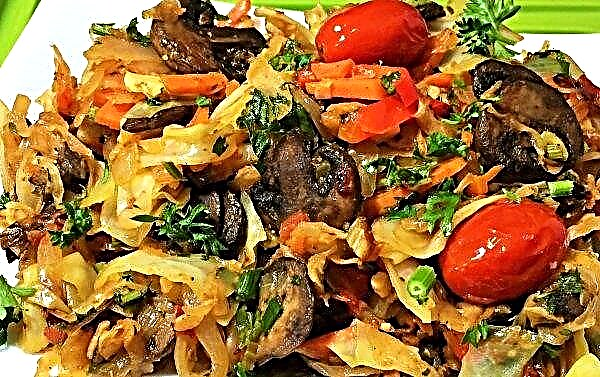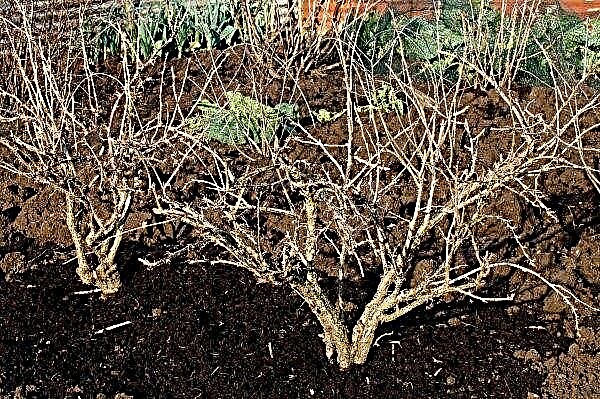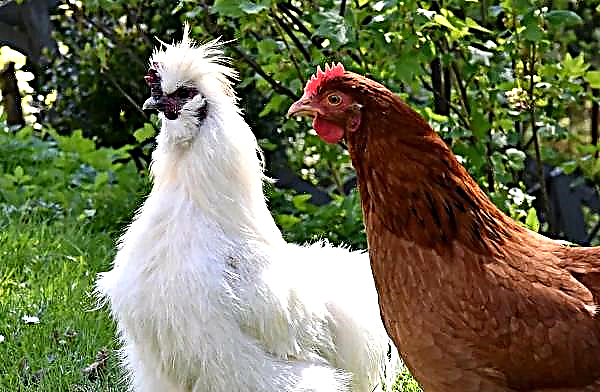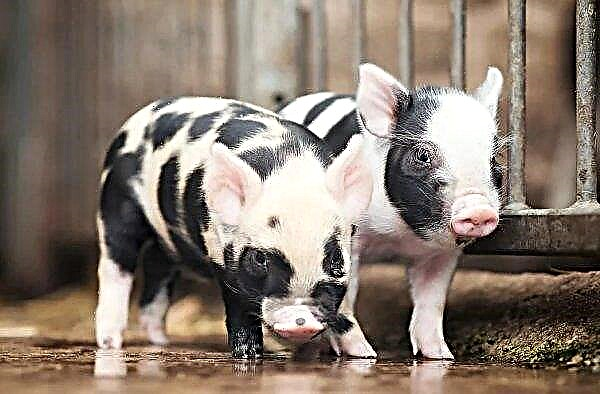The mascot is one of the old, well-established varieties of Ukrainian selection for industrial use. About the features of this variety and its care, read the review.
History of Variety Breeding
The variety was obtained at the Institute of Irrigation Horticulture of the UAAS in 1956. Parent varieties - Drogana Yellow and Valery Chkalov. The development team was led by M. Oratovsky and N. Turovtsev. Sweet cherry is intended for the 6th zone of frost resistance with a minimum winter temperature of –23 ° C.
Description and characteristics of cherries Talisman
It is considered a medium-ripening crop. Fruiting begins at 4 years. Active fruit ripening occurs in the first half of July. The mascot is partially self-fertile, therefore, needs a pollinator companion. This may be the parent variety Valery Chkalov, Bigarro Burlat, April or Skorospelka.
Did you know? Of the thousands of varieties of cherries that are grown in the world, only 10% are suitable for industrial cultivation. This group includes the variety Talisman.
Variety characteristic:
- the tree belongs to vigorous, with a fairly pronounced growth force;
- krone - thick, spherical in shape;
- fruit formations are placed on bouquet branches and growth of the first year;
- characterized by high frost resistance, resistance to frost, fungal diseases;
- It has high productivity - up to 70 kg of fruits from one tree.

Fruits are characterized by:
| The size | up to 20 mm |
| The form | flat heart |
| Weight | 10 g |
| Colour | Dark red |
| Pulp | juicy, semi-crispy, sweet and sour |
| Skin | thin, dense, shiny |
| Bone | medium, easily detachable |
| Peduncle | average |
| Tasting rating | 4.9 points |
| Sugar content | 15.5 Brix |
| Acids | 5,5% |
The fruits are suitable for drying, since the percentage of dry matter in them is more than 23. Sweetness depends on humidity - the higher the indicator during the ripening of the crop, the less sugars the fruits contain.
Advantages and disadvantages of the variety
- The advantages of the Mascot are:
- "Friendly" ripening;
- stable fruiting;
- excellent taste;
- disease resistance;
- frost and frost resistance;
- high productivity.

The purpose of the selection was to obtain cherries for industrial cultivation: with abundant fruiting and resistance to adverse factors. Breeders have fully achieved their goals. Therefore, the flaws of the variety are not noticed.
Features of planting cherries
Growing a variety of Talisman is very simple. It is unpretentious and perfectly adapts to weather conditions. For planting, you will need to pick up a sunny area with good soil drainage. Clay soils are diluted with sand or peat when preparing the landing pit.
To increase the fertility of the land, organic fertilizers are introduced during planting - manure, compost. Cherry prefers neutral soils with an acidity of 6.0 to 7.0 pH, but tolerates other acidity values well.

Avoid low-lying areas where cold air may stagnate or where groundwater is close to the surface. Excessive humidity contributes to the appearance of diseases.
Landing time
You can plant cherries in early spring or autumn, no later than the end of September. But given the fact that these trees can suffer from the effects of low temperatures, give preference to spring planting in April. This will give the tree the opportunity to prepare well for the next winter and take root.
Important! Large and sweet are only those fruits that grow in a sunny area.
Choosing a place to land
Cherries are rather tall trees.
Therefore, choosing a site, pay attention to the following factors:
- the crown should not have obstacles from above in the form of power cables or other communications;
- developed roots should not affect underground utilities and irrigation systems;
- neighboring trees should not intersect with crowns, the distance between them should be at least 2 m.

This is an important fate, as transplanting an adult tree is almost impossible. Therefore, make sure immediately that everything is in order and nothing will interfere with the growth of cherries.
Site preparation
Check soil drainage. Dig a hole with a depth of 1-2 bayonets. Fill with water. If after 2 hours the water will still be in the pit, then this is poorly drained soil and when planting it must be diluted with sand. Conversely, if the water leaves quickly, clay is added to make it more dense.
If the site is hilly, landing is performed on its southern slope. If there is a lowland area, it is recommended to raise the landing zone with the embankment by 15-30 cm, relative to the surrounding area. This is convenient to do using a wooden box as a stop. Its sides will prevent soil erosion.
Important! A tree of the same variety is not suitable for the role of a pollinator. Also do not pollinate cherries with cherries.
At the landing site, the soil should be carefully dug up - this contributes to the development of the root system. Do not dig deeper than the length of the roots. The width is necessarily made 2 times wider than the root system of the seedling.
Direct landing
For planting, you will need a garden shovel and a bucket of compost, rotted manure or other organic fertilizer. Before planting, soak the roots of the seedling in a bucket of water for 1-2 hours. This is necessary, since nurseries supply seedlings with dry roots and in this state it will be difficult for plants to immediately get moisture from the soil.
 Landing technology:
Landing technology:
- Prepare the pit. Depth: about 0.4–0.5 m, width - about 0.6–0.7 m.
- To plant the Talisman and the second pollinator tree, pits are made at a distance of at least 0.5–0.8 m from each other. The exact distance depends on the crown diameter of both trees in adulthood. They should not “overlap” each other.
- Stir the soil with fertilizer.
- Place the tree in the center of the planting hole, straightening the roots.
- Fill the hole, starting from the edge to the center. Make sure that the connection point of the scion and stock is not less than 5 cm from the surface at the end of planting.
- When the pit is half filled, pour 1-2 buckets of water.
- Add soil. Seal it around the trunk.

If the site is located in an area with strong winds, then next to the seedling you can dig a peg and tie a trunk to it. This will give stability. Water it thoroughly during the first month after planting twice a week. Cover the root zone of the surface soil with mulch. This will save moisture in the soil, will inhibit the growth of weeds, soil compaction.
Plant care
Care for the cherries is quite simple.
Like other fruit crops, it consists of:
- glaze;
- fertilizer application;
- pest control.
Sweet cherries need little pruning, with the exception of reducing the height of the crown and removing damaged or dry branches. This simplifies harvesting, does not create excessive shade and prevents pests from appearing on the plant. Pruning is done in the spring before the buds open.
 Like many plants of the Rosaceae family (including apricot and Japanese plum), the leaves of cherries and cherries are moderately poisonous and should not be eaten.
Like many plants of the Rosaceae family (including apricot and Japanese plum), the leaves of cherries and cherries are moderately poisonous and should not be eaten.
Watering and feeding
The frequency of watering depends on the degree of drying of the soil: in the heat it is watered more often. In the first year after planting, watering is carried out 1 time per week. They begin it with the beginning of the growing season in spring and continue until August.
Soil care
After watering, the soil must be loosened. This provides oxygen access to the roots and creates better conditions for their development. If a mulching layer is laid under the tree, then there is no need to loosen it.
Trees need nitrogen, phosphorus and potassium to grow. Nitrogen is responsible for the full formation of leaves and branches. Potassium - for disease resistance and intracellular processes. Phosphorus for the development of the root system. It is also important for the formation of fruits. Sweet cherries are weak nutrients.

Therefore, during the growing season spend only 3 top dressing:
- before budding;
- at the time of opening of flower buds;
- during fruit ripening.
The rate of mineral application is 200–250 g / one adult tree. The percentage ratio of nitrogen, phosphorus and potassium in the composition of top dressing can be 5-10-10.
Cropping and shaping the crown
The natural way to grow a tree is not always the best for fruiting and maintenance. Therefore, gardeners are pruning. This allows you to create better conditions for lighting branches and air circulation in the crown.
Did you know? Marasca cherries (Marasca) is surprising in that there is no stone. These fruits are used to make cocktails. Initially, the variety was used as a treat for the royal family.
Make sure the trimmer is sharpened well. Before proceeding with the manipulation, the secateurs should be disinfected with alcohol. A contaminated tool can cause disease to spread from one tree to another.
Measure the height. Seedlings below 0.8 m are not cut. On a tall tree, the top of the central trunk is cut to a height of 0.9 m at an angle of 45 degrees. After a year, lateral branches form and they will need to be shortened. The crown of sweet cherries is formed in the form of a vase of 4 lateral branches growing at an angle from 45 to 60 degrees. When it is formed, it remains only to “restrain” growth and remove diseased or dry branches.

Diseases and Pests
Spraying from pests can be carried out as they appear, but it is better to clarify which pests are found in your area and spray them on the eve of their appearance. Use insecticides exactly as directed on the package. The main categories of pests are identified by what part of the tree they infect: buds, fruits, wood, leaves.
The main groups of pests and their control:
Most fungal diseases are prevented by spraying the trees with a spray of 1% solution of Bordeaux fluid until the buds open. Variety Talisman is resistant to disease. Therefore, a few treatments are enough: at the beginning and at the end of the season in order to protect the trees.
Harvesting and storage
The fruiting of cherries begins at 4 years after planting. Ripening occurs in early July. Berries acquire a rich red color, become large and sweet. A sign of full maturity is the appearance of birds that will enjoy the fruits. To protect the crop, trees are recommended to be covered with special nets.
Did you know? Raw fresh cherries, rich in bioflavonoids and other antioxidants. She will save them completely if the fruits are frozen immediately after harvest. In addition, freezing concentrates and improves the taste of berries.
The refrigerator will allow you to keep the crop for several days - during the week. Fresh cherries are very juicy, so it is recommended to process them almost immediately. Do not wash fruits until you are ready to use them - otherwise they will deteriorate very quickly.
They can be stored as blanks for the winter, frozen and dried. The mascot is one of the few varieties that are suitable for drying. Before processing, sort the cherries and remove the damaged fruits, so as not to spoil the workpiece.
Variety Talisman is undemanding in care and has many advantages. He is one of the best for industrial cultivation. Observing the simple rules for caring for trees, you can get fairly large yields.

